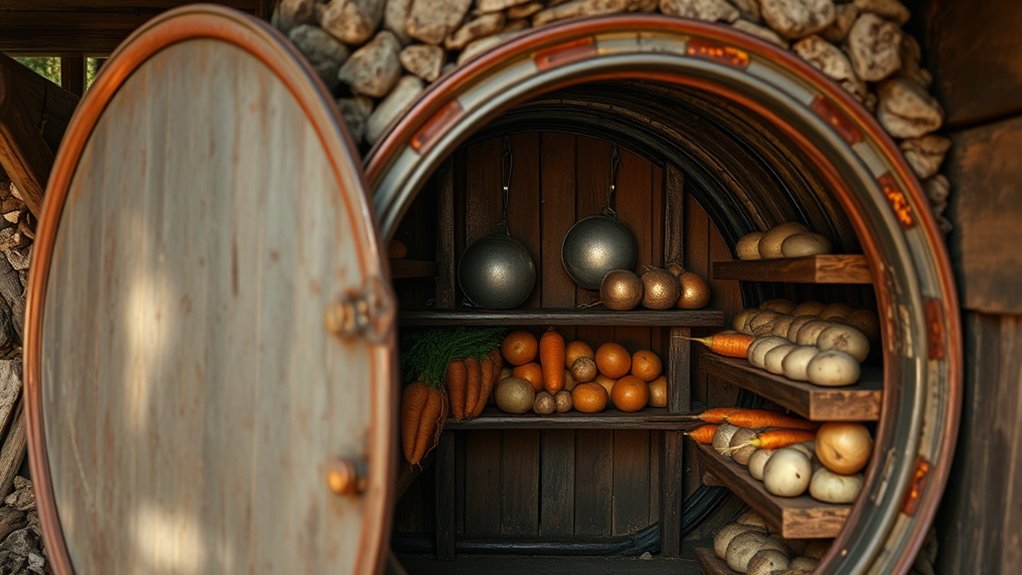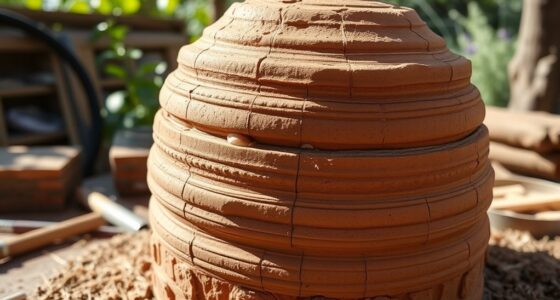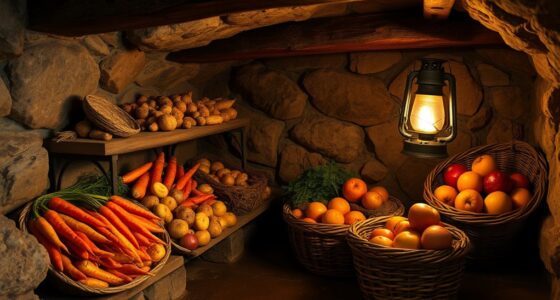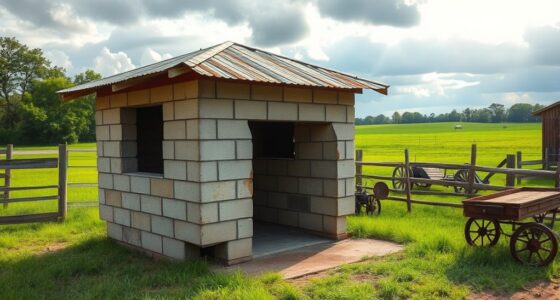To create a simple root cellar from a 55-gallon barrel, start by sanitizing the barrel and choosing a well-drained, shaded spot outdoors. Dig a hole slightly larger than the barrel, position it securely, and fill around it with insulating materials like soil or foam. Add ventilation vents and a sturdy lid to control airflow and keep pests out. For more tips on setup and maintenance, keep exploring how to build an efficient and durable root cellar.
Key Takeaways
- Select a sturdy, rust-free 55-gallon barrel and thoroughly clean it before use.
- Choose a well-drained, shaded site with stable soil for installation to prevent water intrusion.
- Insulate the barrel with foam or spray foam and add ventilation vents near the top and bottom.
- Install a secure, weatherproof lid or cover to maintain temperature and protect against pests.
- Organize interior for optimal airflow and easy access, and monitor humidity and temperature regularly.
Gathering Materials and Tools
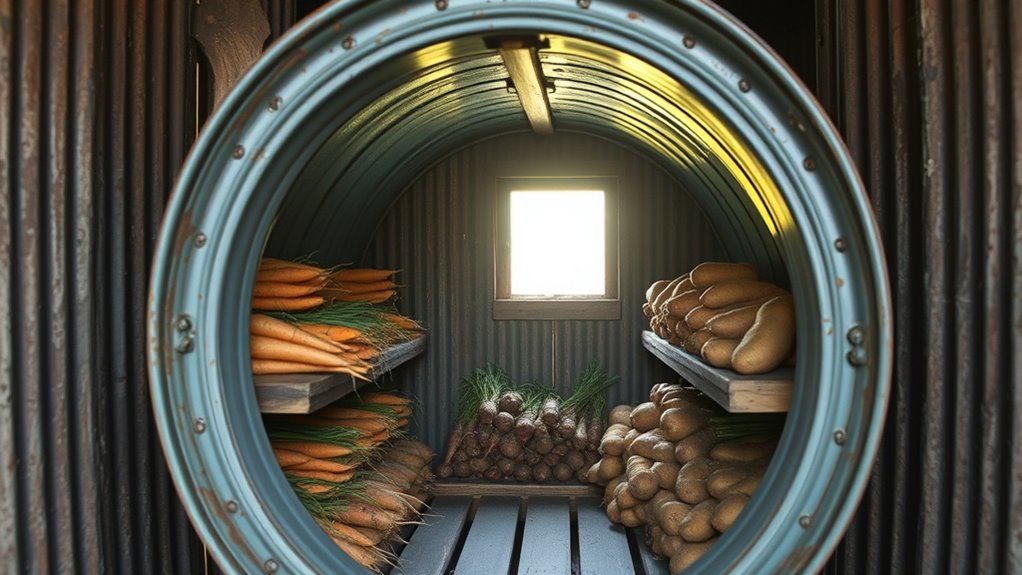
Before you begin transforming a 55-gallon barrel into a root cellar, gather all the necessary materials and tools. Start with careful barrel selection—look for a sturdy, rust-free barrel without leaks or damage. Verify you have sharp tools like a saw, drill, and utility knife for cutting and modifications. Check that your tools are in good condition; sharp blades and well-maintained equipment make the job easier and safer. You might also need a measuring tape, marker, and gloves for safety. Having everything ready before you start helps you work efficiently and prevents interruptions. Remember, proper tool maintenance, like cleaning and sharpening blades, keeps your tools effective throughout the project. Being prepared ensures a smoother transformation process and a durable, functional root cellar. Proper preparation is vital for ensuring safety and efficiency during the project. Additionally, understanding best practices for tool safety can help prevent accidents and ensure a successful build. To further enhance your project, consider researching appropriate safety gear to protect yourself during construction. Involving a knowledgeable helper can also improve safety and efficiency, especially when handling larger or more complex modifications.
Preparing the Barrel for Storage
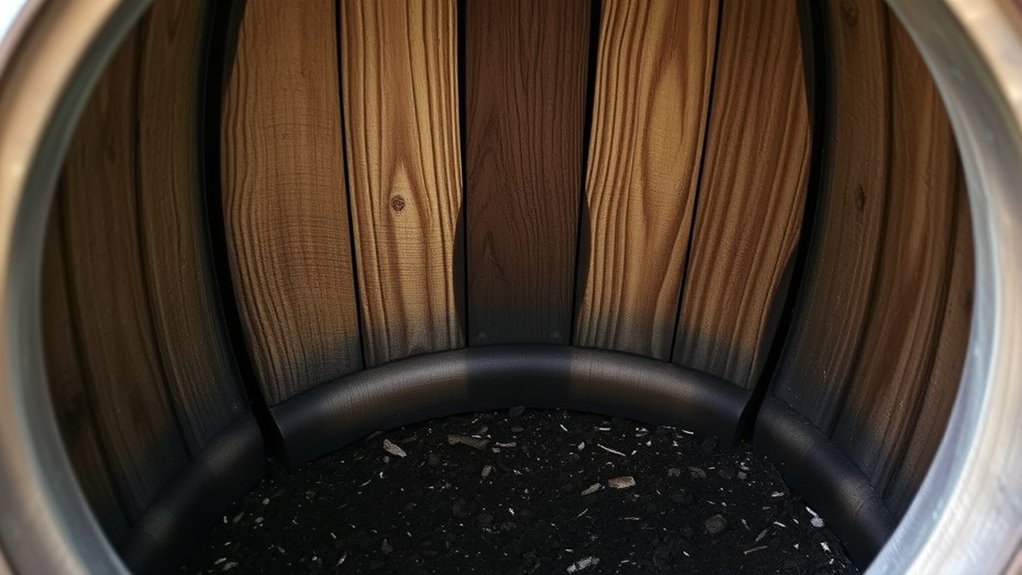
To guarantee your barrel is ready for storage, start by thoroughly cleaning and sanitizing it to eliminate any dirt, mold, or residues that could spoil your stored produce. Once clean, consider barrel customization to suit your aesthetic preferences—paint, stain, or add decorative elements like stencils or natural finishes to make it visually appealing. Ascertain all surfaces are dry before proceeding. You may also want to drill ventilation holes or cut access ports, depending on your design. Proper preparation helps maintain a stable environment inside the barrel, preserving your harvest longer. Adding decorative touches encourages you to take pride in your simple root cellar. With a clean, customized barrel, you’re ready to move on to the next step in creating your effective storage solution.
Digging the Storage Hole

First, you need to pick a spot with good soil stability and easy access. Grab the right tools to make digging smoother and safer. Once you start, check that the soil remains firm around the hole to keep your root cellar secure. Incorporating proper drainage can help prevent water accumulation and protect stored produce. Additionally, selecting a location with adequate ventilation contributes to maintaining proper temperature and humidity levels inside your root cellar. Implementing monitoring systems can further ensure that environmental conditions stay within ideal ranges for your stored crops. Ensuring proper insulation can also help maintain a consistent internal temperature, preventing spoilage. Considering waterproofing techniques can further safeguard your cellar from moisture intrusion and damage.
Choosing the Right Location
Choosing the right location for your root cellar is essential to guaranteeing it stays cool, moist, and protected from the elements. Look for a spot that’s shaded and has good natural insulation, like a hillside or shaded backyard corner. Consider lighting options—using minimal natural light helps keep stored produce fresh longer while preventing mold. Keep pests out by selecting an area away from trees or compost piles, and ensure the site is well-drained to prevent water intrusion. Avoid areas prone to flooding or rapid temperature fluctuations. The right location will make your root cellar easier to maintain, reduce the risk of spoilage, and keep pests at bay. Proper site selection can also help in creating a comfortable environment that mimics the natural conditions of a farmhouse setting, making your root cellar more efficient and reliable year-round. Additionally, choosing a site with natural insulation can significantly improve energy efficiency and maintain consistent storage conditions.
Digging With Proper Tools
Before you start digging, gather the right tools to make the process easier and more efficient. Using proper equipment guarantees safety and helps prevent accidents. Start with sturdy shovels and spades suited for your soil type. Consider using a post-hole digger for precision, and bring a level to check depth. Don’t forget safety precautions like gloves, eye protection, and sturdy boots. Soil testing beforehand is vital to determine soil composition and stability, guiding your digging approach. Here are some essential tools:
- Heavy-duty shovel
- Post-hole digger
- Level
- Gloves and safety glasses
- Measuring tape
Ensuring Soil Stability
Ensuring soil stability is essential once you’ve started digging your storage hole. To prevent walls from collapsing, carefully compact the soil as you go, using a tamper or your feet. Proper soil compaction increases stability and reduces the risk of shifting over time. Additionally, focus on drainage management by grading the surrounding area and installing gravel or drainage pipes if needed. Good drainage prevents water from accumulating around the cellar, which can weaken the soil and cause erosion. Keep the excavation moist but not soaked, as overly dry or overly wet soil can compromise stability. Taking these steps guarantees your root cellar remains secure, dry, and functional for years to come. Proper soil stability is the foundation of a safe, long-lasting storage space.
Installing the Barrel and Insulating

To properly install the barrel as a root cellar, you’ll want to position it in a stable, well-drained spot that maintains consistent temperature and humidity. Once in place, ensure the barrel finishes are smooth and sealed to prevent leaks and pests. When insulating, choose materials like foam board or spray foam to enhance temperature stability. Proper insulation helps keep your root vegetables fresh longer. Here are some tips:
Position your barrel on a stable, well-drained spot and seal it to keep your root vegetables fresh longer.
- Level the barrel securely on a solid base
- Seal cracks around the barrel with weatherproof caulk
- Apply insulation materials evenly around the barrel
- Cover the top with a weatherproof lid or cover
- Check insulation periodically for gaps or damage
- Consider ventilation options to regulate moisture and prevent mold. Using proper insulation materials can also reduce energy loss and maintain a stable internal environment for your stored produce. This setup keeps your root cellar temperature consistent and protects your produce from moisture and pests.
Setting Up Ventilation and Access
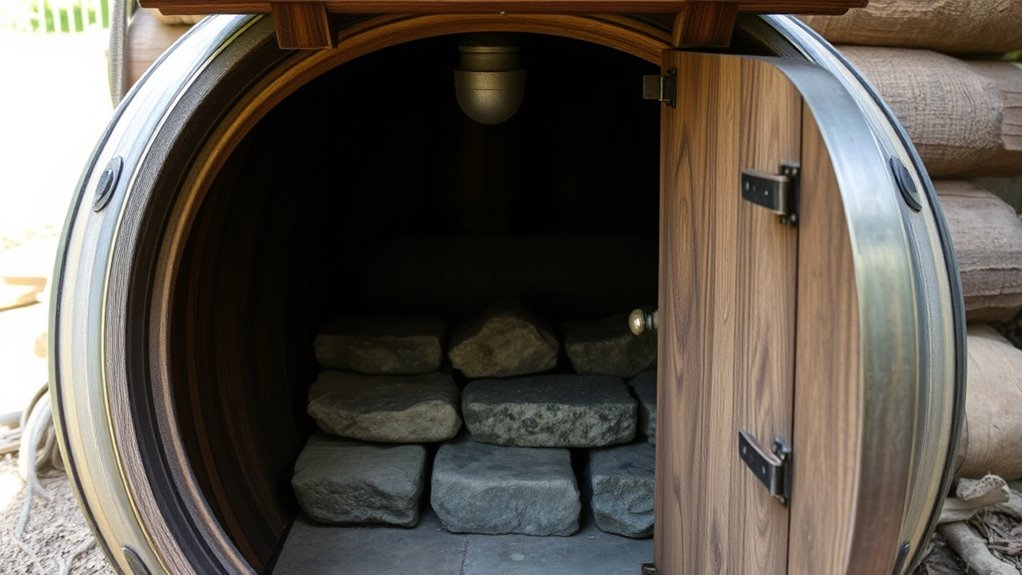
Setting up proper ventilation and access points is essential to maintaining a healthy and functional root cellar. A good ventilation system ensures air circulates, preventing humidity buildup and mold growth. Install vent openings at different heights—one near the top to release warm, moist air and another near the bottom for fresh air intake. Make sure these vents are adjustable to control airflow. Your access door should be sturdy, well-sealed, and easy to open for regular checks and harvests. Position it conveniently but away from direct sunlight and drafts. Properly sealing the access door prevents unwanted temperature fluctuations and pests. Additionally, understanding industry trends can help you optimize your ventilation setup for better climate control. Incorporating energy-efficient ventilation solutions can further reduce operational costs and improve airflow consistency. Properly designed passive ventilation methods can also enhance airflow without additional energy use. Employing insulation techniques can help maintain consistent temperatures within your root cellar, ensuring optimal storage conditions. Considering aesthetic wall organization ideas can facilitate better interior setup and monitoring of air circulation. By focusing on effective ventilation and a secure access point, you’ll keep your root cellar dry, cool, and ready for storing your harvest.
Tips for Maintaining Your Root Cellar
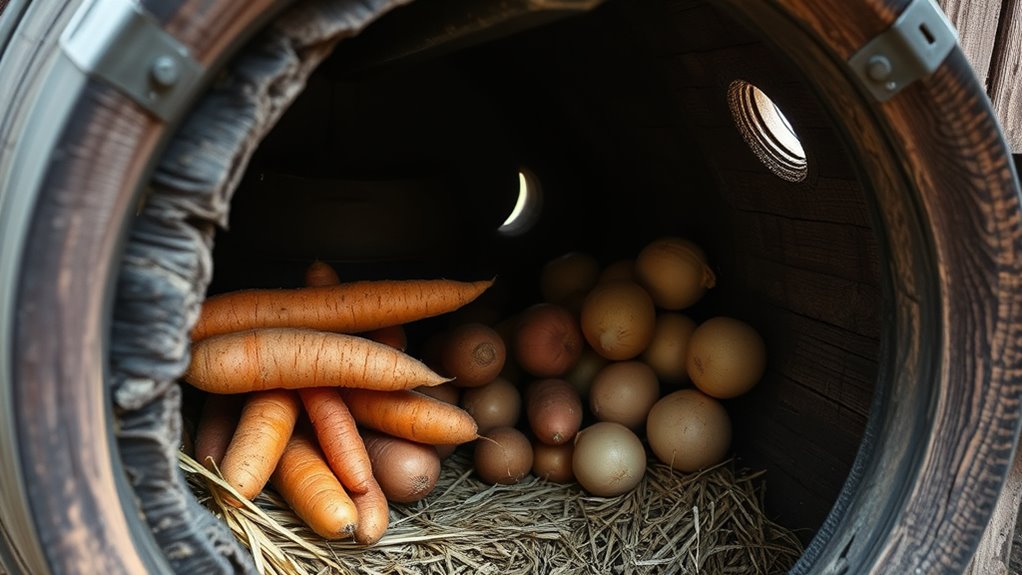
Regularly check your root cellar for signs of excess moisture, mold, or pests, and address issues promptly to keep stored produce fresh. Proper moisture control prevents mold growth and spoiling, while pest prevention keeps critters from damaging your harvest. To maintain your cellar effectively:
- Ventilate regularly to reduce humidity
- Use moisture absorbers like silica packs or charcoal
- Seal any cracks or gaps to keep pests out
- Keep the cellar clean and debris-free
- Store produce in breathable containers
- Monitor environmental conditions using automation tools to ensure optimal storage parameters. Incorporating environmental monitoring can help detect issues early and maintain ideal conditions. Using a temperature and humidity gauge allows for more precise control and helps prevent spoilage caused by incorrect storage conditions. These simple steps help maintain ideal conditions, preserve your produce longer, and prevent problems before they start. Consistent maintenance ensures your root cellar remains a safe, reliable storage space for your harvest. Regular inspections and adjustments, guided by proper climate control, are essential for long-term success. Staying vigilant is key to enjoying fresh, healthy produce all season long.
Frequently Asked Questions
How Long Can Root Vegetables Be Stored in This Type of Cellar?
You can store root vegetables in a barrel cellar for several months, often up to 4-6 months, if you maintain proper conditions. Guarantee barrel insulation keeps the temperature consistent, ideally just above freezing. Good moisture control prevents rot and shriveling, so monitor humidity levels regularly. Proper ventilation also helps. With these measures, your root vegetables will stay fresh and flavorful longer, maximizing your storage time effectively.
What Temperature Range Is Ideal for Storing Produce?
You should aim for a temperature range of 32-40°F to store produce effectively. Proper temperature control slows spoilage, while humidity management keeps roots from shriveling or rotting. Keep the environment consistently cool and slightly humid, adjusting as needed. Regularly check conditions to prevent issues like mold or dehydration. Maintaining this balance guarantees your vegetables stay fresh longer and preserves their flavor and texture.
Can This Barrel Cellar Be Built Indoors?
You can definitely build a barrel cellar indoors. Make sure you control indoor humidity, keeping it stable to prevent produce spoilage. Proper barrel insulation helps maintain consistent temperatures essential for storage. Place the barrel in a cool, dark spot, and consider adding a hygrometer to monitor humidity levels. With these measures, your indoor barrel cellar will effectively preserve produce, mimicking traditional root cellars in a compact, convenient setup.
How Do I Prevent Mold and Pests in the Storage?
Imagine safeguarding your harvest like a fortress against unseen enemies. To prevent mold, keep your storage cool, dry, and well-ventilated, and check regularly for excess moisture. For pest control, seal all entry points tightly and use natural repellents like cedar or diatomaceous earth. These simple steps create a protective barrier, ensuring your stored goods stay fresh and pest-free, giving you peace of mind and a bountiful harvest to enjoy.
Is Special Seasoning or Treatment Needed for the Barrel?
You don’t need special seasoning or treatment for your barrel unless it’s new. For a used barrel, a simple cleaning with water and a vinegar solution usually suffices. If you want to prevent mold and pests, guarantee proper barrel seasoning by drying it thoroughly and sealing any leaks. Generally, treatment requirements are minimal; just keep the barrel clean, dry, and stored in a cool, dark place to maintain its integrity.
Conclusion
Now you’re ready to enjoy fresh, preserved produce all season long. Prepare the space, install your barrel, and maintain it well. Keep it cool, keep it dark, keep it ventilated. By following these simple steps, you’ll create a reliable root cellar, a safe haven for your harvest, and a sustainable solution for storage. Embrace the process, trust your work, and reap the rewards of your homemade root cellar.

